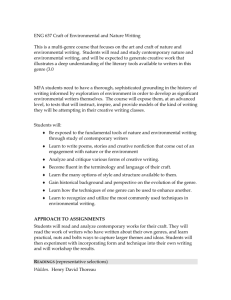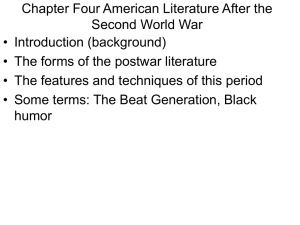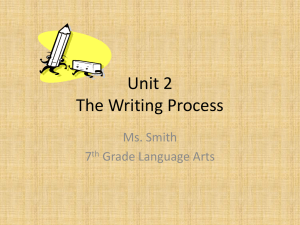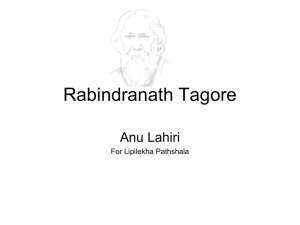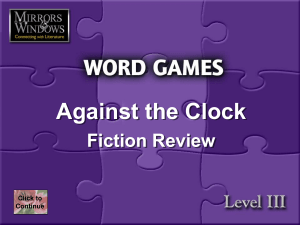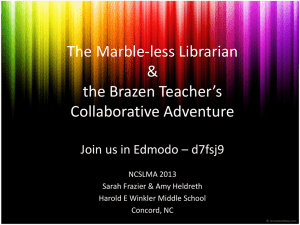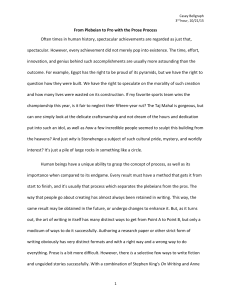Creative Writing Course Descriptions 2014-15
advertisement
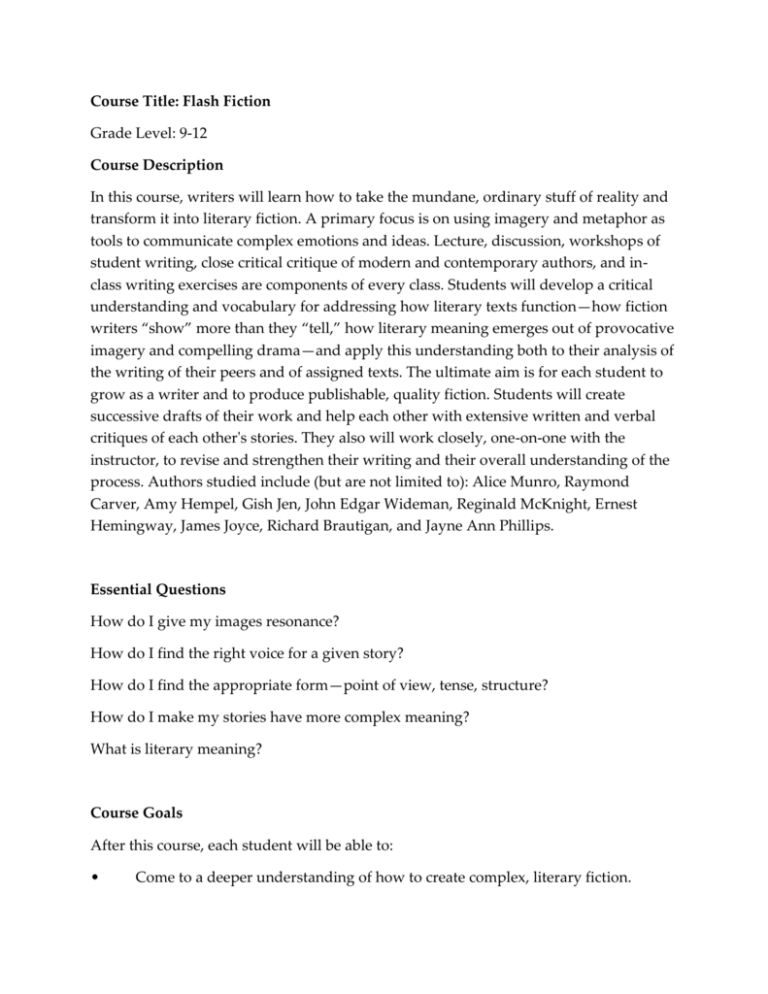
Course Title: Flash Fiction Grade Level: 9-12 Course Description In this course, writers will learn how to take the mundane, ordinary stuff of reality and transform it into literary fiction. A primary focus is on using imagery and metaphor as tools to communicate complex emotions and ideas. Lecture, discussion, workshops of student writing, close critical critique of modern and contemporary authors, and inclass writing exercises are components of every class. Students will develop a critical understanding and vocabulary for addressing how literary texts function—how fiction writers “show” more than they “tell,” how literary meaning emerges out of provocative imagery and compelling drama—and apply this understanding both to their analysis of the writing of their peers and of assigned texts. The ultimate aim is for each student to grow as a writer and to produce publishable, quality fiction. Students will create successive drafts of their work and help each other with extensive written and verbal critiques of each other's stories. They also will work closely, one-on-one with the instructor, to revise and strengthen their writing and their overall understanding of the process. Authors studied include (but are not limited to): Alice Munro, Raymond Carver, Amy Hempel, Gish Jen, John Edgar Wideman, Reginald McKnight, Ernest Hemingway, James Joyce, Richard Brautigan, and Jayne Ann Phillips. Essential Questions How do I give my images resonance? How do I find the right voice for a given story? How do I find the appropriate form—point of view, tense, structure? How do I make my stories have more complex meaning? What is literary meaning? Course Goals After this course, each student will be able to: • Come to a deeper understanding of how to create complex, literary fiction. • Complete a portfolio of polished stories (one long story or 3-5 flash fiction stories). • Become more accomplished at reading their work in front of an audience. • Learn how to do rigorous editing and submit their writing to publications. Course Title: Memoir and Humor Grade level: 9-12 Course Description In this course, students will learn how to elevate writing about the real to the level of art. Additionally, students will learn how to celebrate human frailty by making it the source of humor. Lecture, discussion of course reading, and critiques of successive drafts of students’ works of memoir and humor will be components of every class. Course reading will include the work of established memoirists, essayists, and humorists representative of diverse cultures. Students will learn to sharpen such elements of craft as the creation of resonant imagery and narrative drive, and they will be encouraged to activate their critical vocabularies when analyzing each other’s drafts in the workshop. As well as responding to critiques from fellow students, writers will work intensively with the instructor, receiving criticism on the drafts they have composed in the form of oral and written commentary and line edits. Such attention to detail will enable students to craft final products worthy of publication. Essential Questions How do I discover my subject? How do I create imagistic detail, metaphoric resonance, and narrative drive? How do I negotiate my own creative process? How do I develop and polish writing that is worthy of publication? How do I authoritatively read my work before an audience? How do I offer incisive, supportive feedback on fellow writers’ works-in-process? How do I contribute to an artistic community? Course Goals By the end of this course, each student will be able to: • Understand the meaning and value of aspects of craft such as imagistic detail, metaphoric resonance, and narrative drive • Understand how to provide instructive, supportive feedback on the work of fellow writers • Gain insight into and demonstrate increasing mastery of the many elements of the creative process • Create at least one publishable work of humor or memoir • Authoritatively read work before an audience • Demonstrate generosity of spirit and leadership in the artistic communities of the department and school Course Title: Playwriting: Theatre of the Absurd Course Description What do we mean when we say that something is absurd? Is the word interchangeable with its close synonyms, “preposterous,” “laughable,” and “illogical,” or does it carry special distinction in our lives? This course will require students to examine these questions as we read mid-to-late 20th century plays that follow different dramaturgical rules than the established guidelines for comedy, tragedy, melodrama, or farce. Absurdist playwrights frame their characters within illogical worlds, or reduce the recognizable elements from our world to a bare minimum. Without reliable points of orientation, how do we proceed to understand their artistic aims? And by what criteria do we determine their success? Essential Questions What are the physical, social, or ethical rules that govern this dramatic scenario? How does the play exist in conversation with other artistic experiments in music, dance, and visual art? What are the organizing principles that provide structure in an absurdist play? How do absurdist playwrights upset our expectations regarding plot, character, and spectacle? What is the relationship between form and content? Course Goals After this course, each student will be able to: • Comprehend structure and tone. • Comprehend why a play is successful. • Write with consistency of character. • Understand rising and falling events. • Understand conflict and resolution. • Gain a greater creative and technical vocabulary. • Be capable of critical analysis and creating workshop community. • Understand and apply revisions. • Complete a one-act play. Course Title: Poetry Prerequisite: None Grade level: 9-12 Course Description Students will focus on writing, revision and critical discussion of student poems, and on reading and understanding the craft elements of poems by canonical and contemporary poets, including William Shakespeare, Walt Whitman, Emily Dickinson, Ranier Maria Rilke, Robert Frost, Langston Hughes, Hart Crane, Wallace Stevens, T.S. Eliot, Robert Hayden, William Carlos Williams, Theodore Roethke, Marianne Moore, Elizabeth Bishop, Pablo Neruda, Sylvia Plath, Yusef Komunyaaka, Mark Doty, Lucia Perillo, Rodney Jones, Judy Jordan, Jorie Graham, Rita Dove, Sandra Cisneros, Mark Strand, Lucille Clifton, Robert Hass, Natasha Tretheway, and others. Students’ verbal and written critical analyses of their peers’ work will be informed by their reading of published poems representing a range of formal strategies and historical and cultural contexts, and by their reading in prosody and poetics. Essential Questions What invention strategies might be used to discover the path to a new poem? How can one arrive at a poem’s true subject? What techniques make poems that are unified and powerful? What elements of craft are crucial to an understanding of how a poem does its work? How do earlier poets’ aesthetic choices influences the poets who come after them? Course Goals After this course, each student will be able to: • Learn to come up with rich material that s/he can develop into drafts of poems. • Read poems with a deep understanding of the elements of craft. • Learn invention strategies. • Learn to critique their own and others’ drafts. • Express their ideas using their unique, authentic poetic voices. • Work toward clarity. • Incorporate strong imagery. • Identify and incorporate original, significant and sound metaphor. • Understand and use sound mechanical structure and syntax. • Revise multiple drafts of poems. • Develop strong bonds within their writing community. • Understand the importance of providing frank and honest feedback.
